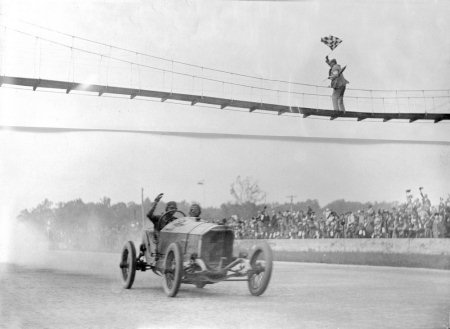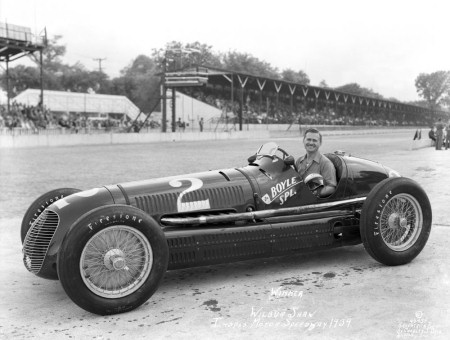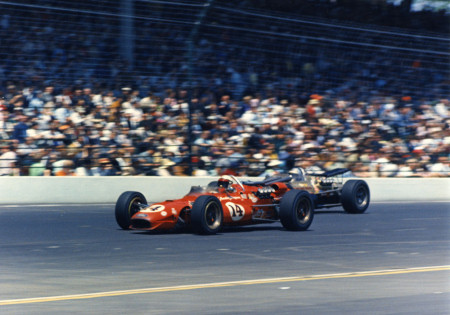The Way It Is/ Appreciating the Speedway's sublime history
by Gordon Kirby The thing that defines the Indianapolis Motor Speedway of course is its superb history. The giant, four-cornered stadium is unique in its layout and longevity, evoking a river of memories, myths and legends for anyone who enters the place. Over the hundred-plus years since the track was opened in 1909 the Speedway has witnessed an amazing evolution of cars and engines and provided a proving ground not only for mechanical things but for many great personalities--drivers, team owners, engineers and mechanics.
The thing that defines the Indianapolis Motor Speedway of course is its superb history. The giant, four-cornered stadium is unique in its layout and longevity, evoking a river of memories, myths and legends for anyone who enters the place. Over the hundred-plus years since the track was opened in 1909 the Speedway has witnessed an amazing evolution of cars and engines and provided a proving ground not only for mechanical things but for many great personalities--drivers, team owners, engineers and mechanics.
This year's 95th running of the 500 celebrates the hundredth anniversary of the first Indianapolis 500, won by Ray Harroun and his locally-built Marmon Wasp. Back in those fledgling days of the auto industry more than fifty automobile manufacturers built cars in Indianapolis but it didn't last long as Detroit's mass-manufacturing giants pushed the little guys out of business.
Meanwhile the cars raced at Indianapolis almost immediately became purpose-built racing machines rather than converted production cars. Indy or AAA championship cars quickly morphed from hulking behemoths to much smaller, leaner machines with comparatively tiny, more efficient engines.
Joe Dawson won the 1912 500 driving a National, another locally-built car, followed by a string of foreign victories. Frenchmen Jules Goux and Rene Thomas won in 1913 and '14 driving Peugeot and Delage respectively. In 1915 Ralph DePalma won aboard a Mercedes and the following year Englishman Dario Resta won not only the 500 driving a Peugeot but also took the first, organized AAA championship winning four more races that summer with his Peugeot.

© Indianapolis Motor Speedway
WWI put the 500 on ice in 1917 and '18 before Howdy Wilcox scored Peugeot's last Indy win in 1919's revival race. Gaston Chevrolet and Tommy Milton drove factory Frontenacs to win the 500 in 1920 and '21 and Jimmy Murphy then ushered in the Duesenberg-Miller era in 1922 with his winning Miller-powered Duesenberg, known as the 'Murphy Special'. Milton and Murphy followed in DePalma's tire tracks as the big stars of the early '20s. Milton won the Indy 500 in 1921 and '23 plus 21 other AAA championship races between 1917-'25. He also won the AAA championship in 1920 and '21. Murphy was Milton's protege and won the 1922 Indy 500 plus 18 other AAA races between 1920-'24. Murphy also posthumously won the 1924 AAA title.
Milton and Murphy were also the first men to break the 150 mph barrier driving a twin-engined Duesenberg designed by Milton to break the land speed record on Daytona Beach. And of course, Murphy scored an historic victory in the 1921 French Grand Prix with the factory Duesenberg team. Murphy's win was the first all-American victory in Grand Prix racing, a feat that would not be duplicated until Dan Gurney won the 1967 Belgian GP aboard his own Eagle-Weslake F1 car.
Milton and Murphy were also party to the Duesenberg-Miller rivalry which raged through the '20s in company with the great board track era as AAA championship racing and the 500 became strictly American preserves. Known as the 'Golden Age' the board-track era produced spectacular speeds and drew huge crowds as Fred and Augie Duesenberg and their rival Harry Miller developed supercharging and front wheel drive with star drivers such as Milton, Murphy, Frank Lockhart and Peter DePaolo.
Lockhart's star burned brightly for just two years from his rookie victory in the 1926 Indy 500 through his death at the wheel of his spectacular Stutz Black Hawk land speed record car on Daytona Beach in April, 1928. In between, Lockhart was the man to beat at Indianapolis and in AAA championship racing, dominating the '27 500 until his engine failed and winning nine other AAA races prior to his early death.
As the thirties and the Depression years arrived the board tracks vanished and the AAA championship struggled with only three or four races in the years prior to WWII. Miller-powered cars continued to dominate but in 1935 Kelly Petillo scored the first 500 victory for an Offenhauser-powered car after Fred Offenhauser took over Harry Miller's bankrupt business.
The first three-time winner of the 500 was Louis Meyer who won in 1928, '33 and '36. Meyer started a dozen 500s between 1928-'39 and also finished second in '29. After WWII Meyer and Dale Drake bought Fred Offenhauser's operation and Meyer-Drake Engineering continued to manufacture the venerable Miller-based, four-cylinder for more than a third of a century. The Offy dominated AAA and USAC championship racing through the fifties and into the sixties and enjoyed a second life in turbocharged form through the seventies.

© Indianapolis Motor Speedway
Rex Mays and Ted Horn were two great Indy car drivers from the '30s and '40s who never won at Indianapolis. Mays finished second to Shaw at Indianapolis in 1940 and '41 and was on the pole in four of the twelve Indy 500s he started and also won the AAA championship in 1940 and '41. Horn won the AAA title in 1946, '47, and '48 and finished third or fourth in eight straight Indy 500s from 1937-'48. He was second to Louis Meyer in '36.
In the years following WWII most of the cars at Indianapolis were dirt cars although Mauri Rose and Bill Holland showed that custom-built Indy cars were the way to go as they dominated the 500 in 1947, '48 and '49 with their Offy-powered Blue Crown Specials. Rose became the third three-time winner, taking the checkered flag in 1941, '47 and '48, while the Blue Crowns were a prelude to the fabulous roadster era of the fifties and early sixties.
The roadsters were beautiful cars, almost invariably Offy-powered and led by Frank Kurtis who had built many successful midgets. Johnnie Parsons scored Kurtis's first Indy 500 win in 1950 and Kurtis chassis proceeded to win six 500s in a row through 1955. Bill Vukovich was the man to beat from 1952-'55 aboard a trio of Kurtis roadsters and most of the starting field in those days were Kurtis chassis.
Vukovich started five Indy 500s and won the race in 1953 and '54 driving a series of Howard Keck's beautiful Kurtis 500-Offenhausers. Vukovich dominated the 500 for four years in a row from 1952-'55 but he fell out of the '52 race with just ten laps to go when his steering failed while he was leading and was killed in '55 when leading comfortably yet again, an innocent victim of a multi-car accident. Vukovich led 485 of the 676 laps he completed at the Speedway over five races from 1951-'55, a remarkable achievemet.
During Vukovich's short reign at the apex of the sport a fleet of American car builders and chief mechanics began to copy or better Kurtis's designs. Guys like George Salih, Quin Epperly, Eddie Kuzma, Lujie Lesovsky, Floyd Trevis and A.J. Watson developed their own roadsters. All used Offy engines but most teams built their own engines and everyone took pride in doing their own thing with chassis and bodywork too. That era produced many great drivers like Troy Ruttmann, Tony Bettenhausen, Jimmy Bryan, Jim Rathmann and Rodger Ward but the greatest of them all was A.J. Foyt, the first man to win four Indy 500s.
Foyt arrived at the Speedway as a rookie in 1958, won the first of his record seven USAC championships in '60 and took his first 500 in '61 aboard a Trevis roadster, famously beating Eddie Sachs after Sachs stopped with two laps to go to change a shredding tire. Foyt won again in '64 aboard his own Watson roadster and scored his third win in 1967 in a rear-engined Lotus-based Coyote-Ford V8. Foyt's fourth win in the 500 came ten years later at the wheel of a Bob Riley-designed Coyote-turbo Foyt/Ford V8.
The other great star of the early sixties was Parnelii Jones who won the 500 just once in 1963 aboard J.C. Agajanian's Watson roadster, but led five of the seven 500s he started for a total of 492 laps. Parnelli also started on the first two rows in all seven 500s he ran. He retired from open cockpit racing after almost winning the 500 a second time in 1967 aboard Andy Granatelli's STP turbine car.
The roadster era lasted into the early sixties when the rear-engined revolution arrived led by Colin Chapman, Jim Clark and Dan Gurney. The arrival of rear engines brought British car builders like Lotus, Lola and McLaren to the Speedway but America's car builders fought back, most notably Gurney's Eagles, A.J. Foyt's Coyotes, Parnelli Jones's Parnellis and Pat Patrick's Wildcats. Through the sixties and seventies and into the eighties speeds skyrocketed as rear engines were followed by the advent of the modern, low-profile tire, wings, turbocharging and finally ground-effect aerodynamics.

© Indianapolis Motor Speedway
By the time CART took control of Indy car racing (Indy 500 excepted) in 1980 the long tradition of successful American Indy cars was beginning to wane as UK car builders Lola, March and Reynard began to dominate the market from the late seventies through the turn of the century. Penske's cars were also built in the UK and Johncock's 1982 500 win in one of Pat Patrick's Wildcats interrupted a twenty-year run of UK-built Indy winners.
The great stars of the CART era were led of course by Rick Mears, a four-time Indy 500 winner in 1979, '84, '88 and '91 and three-time CART champion in 1979, '81 and '82. Mears stands in a class of his own as the only man to win the Indy 500 pole six times. CART's other big names included Mario Andretti, Bobby Rahal, Danny Sullivan, Al Unser Jr. and Michael Andretti. Sullivan won the 500 with Penske in 1985, Rahal won with Truesports in '86 and Al Jr. won with Rick Galles in 1992 and Penske in '94. Michael Andretti is renowned as the driver who led the most laps (431) in the 500 but was unable to win the big race.
The CART era was followed by the arrival of the IRL with its Anglo-American G Force/Panozes and Italian Dallaras. By 2007 Dallara had vanquished Panoz and today all the cars are built by Dallara in Italy with Honda engines powering the entire field. Next year promises something slightly different with new Dallaras and engines from Ilmor/Chevrolet and Lotus as well as Honda.
A similar change has occured among the drivers. The only non-Americans to win the 500 over seventy years from 1919-'88 were Jim Clark in 1965 and Graham Hill in '66. But after Emerson Fittipaldi scored the first of his two 500 wins in 1989 only six Americans--Rick Mears, Al Unser Jr. (twice), Buddy Lazier, Eddie Cheever, Buddy Rice and Sam Hornish--have won the race. Hornish in 2006 was the 500's last American winner.
Today's most accomplished drivers at Indianapolis are Helio Castroneves and Dario Franchitti. Castroneves is looking for his fourth Indy win but the Brazilian has never won a championship. Franchitti on the other hand has three IndyCar titles to compliment his pair of wins in the 500 and is considered to be a more complete driver than Castroneves. He may be the only driver among the current crop to find a place among the Speedway's greatest drivers.
On all fronts these are very different times to 100 years ago and we look ahead with great interest to see what the second century of motor racing begins to bring to the Indianapolis Motor Speedway.
Auto Racing ~ Gordon Kirby
Copyright 2011 ~ All Rights Reserved
Copyright 2011 ~ All Rights Reserved
Top of Page